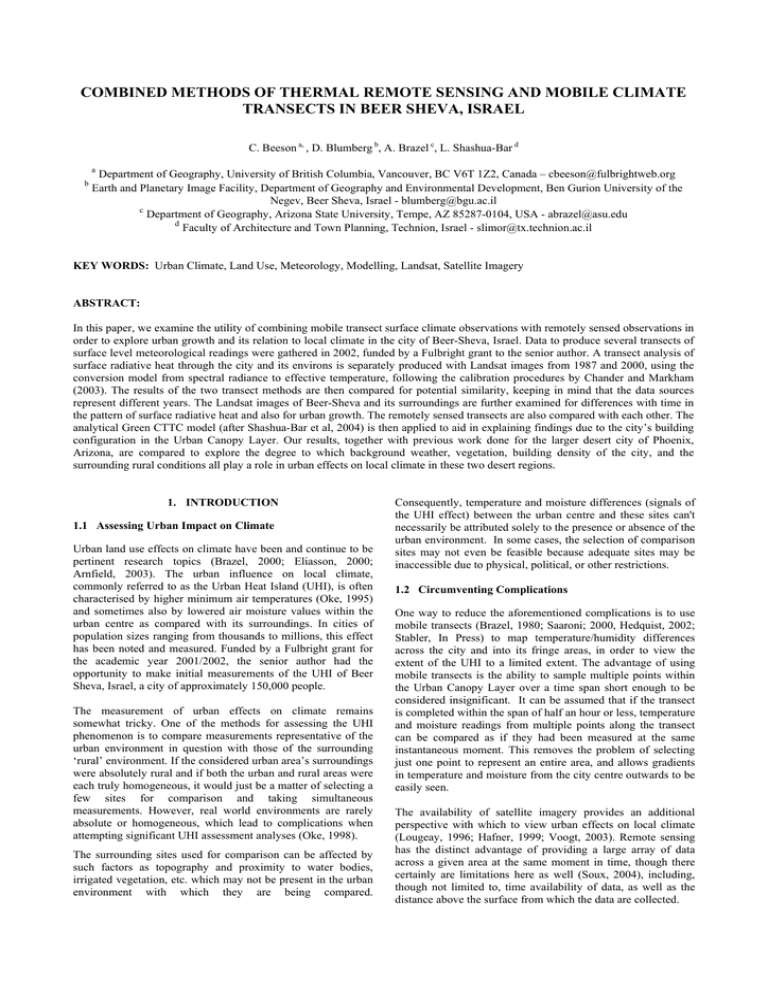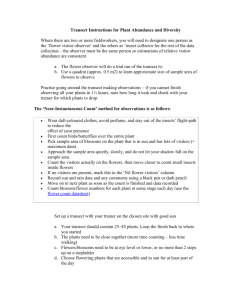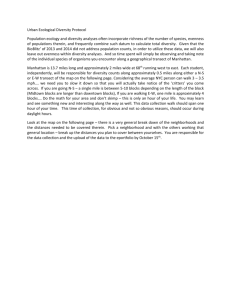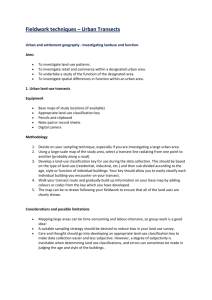COMBINED METHODS OF THERMAL REMOTE SENSING AND MOBILE CLIMATE
advertisement

COMBINED METHODS OF THERMAL REMOTE SENSING AND MOBILE CLIMATE TRANSECTS IN BEER SHEVA, ISRAEL C. Beeson a, , D. Blumberg b, A. Brazel c, L. Shashua-Bar d a b Department of Geography, University of British Columbia, Vancouver, BC V6T 1Z2, Canada – cbeeson@fulbrightweb.org Earth and Planetary Image Facility, Department of Geography and Environmental Development, Ben Gurion University of the Negev, Beer Sheva, Israel - blumberg@bgu.ac.il c Department of Geography, Arizona State University, Tempe, AZ 85287-0104, USA - abrazel@asu.edu d Faculty of Architecture and Town Planning, Technion, Israel - slimor@tx.technion.ac.il KEY WORDS: Urban Climate, Land Use, Meteorology, Modelling, Landsat, Satellite Imagery ABSTRACT: In this paper, we examine the utility of combining mobile transect surface climate observations with remotely sensed observations in order to explore urban growth and its relation to local climate in the city of Beer-Sheva, Israel. Data to produce several transects of surface level meteorological readings were gathered in 2002, funded by a Fulbright grant to the senior author. A transect analysis of surface radiative heat through the city and its environs is separately produced with Landsat images from 1987 and 2000, using the conversion model from spectral radiance to effective temperature, following the calibration procedures by Chander and Markham (2003). The results of the two transect methods are then compared for potential similarity, keeping in mind that the data sources represent different years. The Landsat images of Beer-Sheva and its surroundings are further examined for differences with time in the pattern of surface radiative heat and also for urban growth. The remotely sensed transects are also compared with each other. The analytical Green CTTC model (after Shashua-Bar et al, 2004) is then applied to aid in explaining findings due to the city’s building configuration in the Urban Canopy Layer. Our results, together with previous work done for the larger desert city of Phoenix, Arizona, are compared to explore the degree to which background weather, vegetation, building density of the city, and the surrounding rural conditions all play a role in urban effects on local climate in these two desert regions. 1. INTRODUCTION 1.1 Assessing Urban Impact on Climate Urban land use effects on climate have been and continue to be pertinent research topics (Brazel, 2000; Eliasson, 2000; Arnfield, 2003). The urban influence on local climate, commonly referred to as the Urban Heat Island (UHI), is often characterised by higher minimum air temperatures (Oke, 1995) and sometimes also by lowered air moisture values within the urban centre as compared with its surroundings. In cities of population sizes ranging from thousands to millions, this effect has been noted and measured. Funded by a Fulbright grant for the academic year 2001/2002, the senior author had the opportunity to make initial measurements of the UHI of Beer Sheva, Israel, a city of approximately 150,000 people. The measurement of urban effects on climate remains somewhat tricky. One of the methods for assessing the UHI phenomenon is to compare measurements representative of the urban environment in question with those of the surrounding ‘rural’ environment. If the considered urban area’s surroundings were absolutely rural and if both the urban and rural areas were each truly homogeneous, it would just be a matter of selecting a few sites for comparison and taking simultaneous measurements. However, real world environments are rarely absolute or homogeneous, which lead to complications when attempting significant UHI assessment analyses (Oke, 1998). The surrounding sites used for comparison can be affected by such factors as topography and proximity to water bodies, irrigated vegetation, etc. which may not be present in the urban environment with which they are being compared. Consequently, temperature and moisture differences (signals of the UHI effect) between the urban centre and these sites can't necessarily be attributed solely to the presence or absence of the urban environment. In some cases, the selection of comparison sites may not even be feasible because adequate sites may be inaccessible due to physical, political, or other restrictions. 1.2 Circumventing Complications One way to reduce the aforementioned complications is to use mobile transects (Brazel, 1980; Saaroni; 2000, Hedquist, 2002; Stabler, In Press) to map temperature/humidity differences across the city and into its fringe areas, in order to view the extent of the UHI to a limited extent. The advantage of using mobile transects is the ability to sample multiple points within the Urban Canopy Layer over a time span short enough to be considered insignificant. It can be assumed that if the transect is completed within the span of half an hour or less, temperature and moisture readings from multiple points along the transect can be compared as if they had been measured at the same instantaneous moment. This removes the problem of selecting just one point to represent an entire area, and allows gradients in temperature and moisture from the city centre outwards to be easily seen. The availability of satellite imagery provides an additional perspective with which to view urban effects on local climate (Lougeay, 1996; Hafner, 1999; Voogt, 2003). Remote sensing has the distinct advantage of providing a large array of data across a given area at the same moment in time, though there certainly are limitations here as well (Soux, 2004), including, though not limited to, time availability of data, as well as the distance above the surface from which the data are collected. Remotely sensed data used in conjunction with measured in situ data can result in fairly accurate representations of local urban climate in the form of climate modelling (Shashua-Bar, 2004). The addition of simulation models to the UHI analysis lends depth to the overall picture. 2. COMBINED TRANSECT METHODS AND THE GREEN CTTC MODEL 2.1 Mobile Transects A mobile transect route was chosen which could be completed within a half hour time constraint and which included two fringe areas outside of the city as well as a good portion of the Beer Sheva city centre. During each mobile transect, Relative Humidity measurements, which were later converted into dew point (Td) values, and air temperature (Ta) measurements were collected at selected time intervals by means of sensors mounted onto a vehicle. GPS equipment was used to track the location of the vehicle at all times. Both the meteorological and GPS data were recorded using a Campbell Scientific datalogger carried inside the vehicle. Data was collected during the time of year when the UHI was anticipated to be most apparent from previous years’ climate data. Measurements were taken at the same relative time of day for each sampling period, including both daytime and nocturnal measurements. Only clear, calm days were chosen, in order to remove variability caused by differences in advection, insolation, etc. 2.2 Remotely Sensed Transects Figure 1 shows the growth of the city of Beer Sheva from a 1987 satellite image to a 2000 satellite image. A considerable extension of urban sprawl can be seen in the western side of the city. To a certain degree, the same can be seen in the Southeast near the clearly visible agricultural region. Two surface temperature transects across Landsat images from 1987 and 2000 were later created from NE-SW (Figures 2a and 2b) and from NW-SE (Figures 3 and 4) This was done using the conversion model from spectral radiance to effective temperature with parameters provided by the USGS for TM images (1987 image) and ETM (2000) images following the calibration procedures by Chander and Markham (2003). Referring to Figure 1, an area of land use change is clearly shown from 1987 to 2000, just beyond the NE edge of the city. This is evidenced by the grey patch in the 2000 image, which does not appear in the earlier one. Correspondingly, from 1987 to 2000, a notable shift in the data belonging to the NE portion of the image transect is visible in Figure 2b. Figure 1. Changes in the city of Beer Sheva from 1987 (left) to 2000 (right) Figure 2a. NE-SW remotely sensed transect - displayed on 1987 image Figure 3. SE-NW remotely sensed transect (red) and mobile transect route (black) – displayed on 1987 image Image T ransect NE-SW 294 1987 Image 293 2000 Image Combined T ransect Data 1987 Image 2000 Image Mobile Transect Ta Mobile Transect Td 22 20 292 18 291 16 290 Temperature (C) Temperature (Kelvin) 295 289 288 287 14 12 10 8 6 4 286 2 285 0 1000 2000 3000 4000 5000 6000 0 Data Points from SE to NW Distance (m) Figure 2b. Data plot of NE-SW remotely sensed transect Figure 4. Data comparison between transects Referring to Figure 3, the Landsat transect (in red) and the route of the mobile transect (in black) are superimposed upon a 1987 image of the city of Beer Sheva. Though the Landsat transect is comprised of a straight line, whereas the mobile transect route is clearly not, the data from each form very similar patterns when viewed by relative area. It is worth mentioning that it is the mobile transect Td trace, and not the Ta trace, that seems to correlate with the image data trace. Even in this unrefined analysis, it is clear that the processes occurring within the Urban Canopy that result in the noontime dry city centre air, accompanied by moister suburban/fringe air, do relate to the ‘temperatures’ that thermal remote sensors ‘see’ from far above the surface, even during a completely different year. This highlights the important role that moisture plays in urban effects on local climate. For purpose of comparison, both data sets were converted into similar area averages, with each point representing an average of data covering the length of approximately 100 m. When viewing the results of the two types of transects plotted together (Figure 4), it is first interesting to note the shift of the SE temperature dip and peak from the 1987 image to the 2000 image. This again illustrates the ways in which land use modification can affect local climate. Also of note is the similarity between the behaviour of the mobile transect Td trace and that of the trace generated from the 2000 image. This is especially significant when considering that the image data were collected in midmorning on Feb 15 2000, whereas the transect data were measured at noon on Feb 08 2002. The fact that the traces show peaks and dips in roughly the same areas on two distinct occasions separated by two years’ time strongly suggests that the results from both types of transects have the potential to represent more than just one isolated day. 2.3 Green CTTC Model Using the Green CTTC model, an additional endeavour was made to characterise the UHI effect local to Beer Sheva, Israel. The parameters involved in the model simulations were based on area average estimates and included: mean solar radiation absorptivity of the ground, m = 0.45; the overall heat transfer coefficient of the surface, h (in this case averaging 2 13 W / m K ), which is associated with the wind velocity; the effective atmospheric emissivity, Br (in this case averaging 0.75), which is affected by the vapour pressure and cloudiness of the climatic region,; ground surface thermal emissivity, ε = 0.92; and the Ground Cluster Thermal Time Constant, CTTC = 7 hours. The measured data that were used as inputs for the analysis were area-averaged samples of air and dew point temperatures measured during the mobile transects that were performed at 20:00 on February 7 2002 and at 1:30, 6:00 and 12:00 on February 8 2002. The model was first validated by using it to simulate the diurnal air temperature variations of an urban open space in the City of Beer-Sheva on Feb 7-8 2002, and then plotting the results with corresponding data from a meteorological (Wx) station at BenGurion University (see Figure 5). The results compare quite well. The vegetation influence depends on its percent coverage. Area 1 has the highest coverage estimated at 50%, and its effect was estimated as 1.0 °C at noon. Area 3 is affected by the surrounding green area, on the average estimated at 40% coverage, with an effect of 0.77 °C. The green coverage is less in the city centre of Area 2, estimated at 30% on the average, and its effect is 0.34 °C. The trend of the vegetation influence is assumed to apply to winter conditions. In summer, the effect of the vegetation is expected to exceed these values, because of an anticipated increase in the evapotranspiration rate. 24 22 20 Air Temperature [C] At noon the transect data area average for the city centre (Figure 7) is 1.25 °C higher than the BGU Wx Station measurement (located in more of a suburban area). However, this difference is very small in the outlying areas for the same time. Using the model simulation, the factors that led to that difference were estimated to result from the building influence, represented by H/W, the vegetation influence and the anthropogenic influence. 18 16 14 The simulated values as per the analytical model did not include consideration of anthropogenic influences, hence the difference between the transect data and the simulated values that include vegetation offers an approximation of the anthropogenic influence and of other factors not considered in the model. 12 10 8 4 6 8 10 12 14 16 18 20 22 24 2 4 Time [hr] 24 Simulated Data BGU Wx Station Figure 5. Initial model results 22 In the next stage, the model was applied to simulate the diurnal air temperature at three areas of interest (Figure 6), with and without the inclusion of green coverage. Again, the simulated values were compared with the measured values in situ at 6:00, 12:00, 20:00 and 1:30 h, in 7-8/2/2002. Air Temperature [C] 20 18 16 14 12 10 8 4 5 6 7 8 9 10 11 12 13 14 15 16 17 18 19 20 21 22 23 24 1 2 3 4 Time [hr] Meteorological Station - January Mobile Transect data 1 simulated data with H/W=0.5 simulated data with H/W=0.5 and 20% g 2 Figure 7. Area 2 model simulation results 3 Figure 6. Areas 1-3 superimposed on 1987 image and SE-NW transect; small white circle represents the BGU Wx Station Area 1 is located at the Northwest edge of the city and consists of private residences. This area is estimated to have a H/W = 0.25 and vegetation coverage of about 50%. Area 2 contains the city centre, with streets flanked by buildings averaging 4 to 5 floors, estimated as H/W = 0.5, and with vegetation coverage of about 20 to 30%. Area 3 is located at the Southeast edge of the city, crossing through an industrial and agricultural area estimated as H/W = 0.15 and influenced by green areas estimated at 40% vegetation coverage. 3. CONCLUSIONS Remote sensing techniques can aid particularly in identifying the spatial variability of the earth’s surface climate. Remote sensing in concert with modeling and measurement techniques provide a rich assessment of how surface climate changes across urban-rural gradients in cities. In our case study, the impact of moisture gradients are highlighted in the remote sensed IR temperatures at that scale, whereas a holistic treatment of vegetation coverage and H/W data at local scales also explained a significant variability of air temperatures measured across the city. These findings are similar, although different in magnitude due to city size, to the Southwestern USA city of Phoenix, Arizona (e. g., Lougeay et al, 1996 and Stabler, et al in Press). Stabler, L. B., C. A. Martin, A. J. Brazel. In Press. Microclimates in a desert city related to land use and vegetation index, Urban Forestry & Urban Greening. Voogt, J. A., T. R. Oke, 2003. Thermal remote sensing of urban climates, Remote Sensing of Environment, 86, pp. 370-384 4. REFERENCES Arnfield, J. A., 2003. Two decades of urban climate research: a review of turbulence, exchanges of energy and water, and the urban heat island, International Journal of Climatology, 23, pp.1-26. Brazel, A., D. Johnson, 1980. Land use effects on temperature and humidity in the Salt River Valley, Arizona, Journal of Arizona-Nevada Academy of Science, 15, pp. 54-61. Brazel, A., N. Selover, R. Vose, G. Heisler, 2000. The tale of two climates - Baltimore and Phoenix urban LTER sites, Climate Research, 15, pp. 123-135. Chander, G., B. L. Markham, 2003. Revised Landsat 5 TM radiometric calibration procedures and post-calibration dynamic ranges, IEEE Transactions on Geoscience, 41, pp. 2674-2677. Eliasson, I., 2000. The use of climate knowledge in urban planning, Landscape and Urban Planning, 48, pp. 31-44. Hafner, J., S. Q. Kidder, 1999. Urban heat island modeling in conjunction with satellite-derived surface/soil parameters, Journal of Applied Meteorology, 38(4), pp. 448-465. Hedquist, B., 2002. Spatio-temporal variation in the Phoenix East Valley urban heat island, MA thesis, Arizona State University, 63 pp. Lougeay, R., A. Brazel, M. Hubble, 1996. Monitoring intraurban temperature patterns and associated land cover in Phoenix, Arizona using Landsat thermal data, Geocarto International, 11(4), pp. 79-90. Oke, T. R., 1995. The heat island of the urban boundary layer: characteristics, causes and effects, Wind Climate in Cities, J. E. Cermak et al. (eds.), NATO ASI Series E, 277, pp. 81-107 Oke, T. R., C. S. B. Grimmond, R. A. Spronken-Smith, 1998. On the confounding role of rural wetness in assessing urban effects on climate. In: The AMS Meetings of 2-7 November 1998 in Albuquerque, New Mexico, The Second Symposium on Urban Environment, 5.1. Saaroni, H., E. Ben-Dor, A. Bitan, O. Potchter, 2000. Spatial distribution and Microscale characteristics of the urban heat island in Tel-Aviv, Israel, Landscape and Urban Planning, 48, pp. 1-18. Shashua-Bar, L., 2004. Thermal effects of building geometry and spacing on the urban canopy layer microclimate in a hothumid climate in summer, International Journal of Climatology, 24, pp. 1729-1742. Soux, A., J. A. Voogt, T. R. Oke, 2004. A model to calculate what a remote sensor ‘sees’ of an urban surface, BoundaryLayer Meteorology, 111, pp. 109-132.




